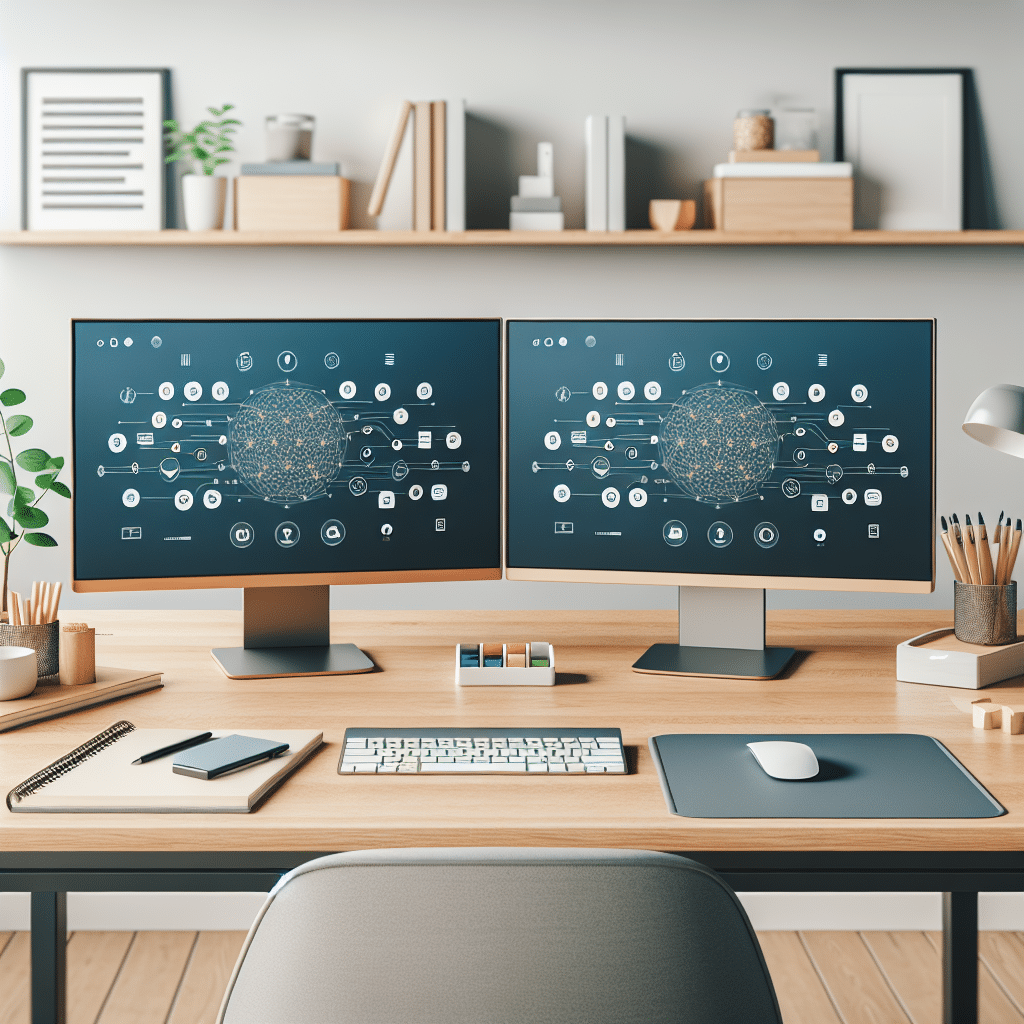Understanding Dual Monitor Benefits
A dual monitor setup can significantly enhance productivity, efficiency, and multitasking capabilities. By providing additional screen real estate, users can manage multiple applications simultaneously. This setup benefits professionals in industries such as graphic design, programming, finance, and virtual collaboration.
Assessing Desk Space
Before setting up dual monitors, it’s crucial to evaluate the available desk space. Ideally, the monitors should be positioned so they are at eye level and easily accessible. Measure the dimensions of the desk and consider how much additional width the monitors will require. A sturdy, spacious desk specifically designed for dual monitor setups can optimize the working environment.
Choosing the Right Monitors
-
Size and Resolution: Select monitors with similar sizes and resolution to maintain a cohesive visual experience. Ideally, a 24-inch or larger monitor with a 1920×1080 resolution (Full HD) works well for most professionals. For design tasks, consider monitors with higher resolutions such as 2560×1440 (QHD) or 3840×2160 (4K).
-
Panel Type: There are three primary types of display panels: IPS, TN, and VA. IPS panels are renowned for color accuracy and viewing angles, making them ideal for creative professionals. TN panels, while less expensive, have quicker response times but poorer color reproduction. VA panels provide better contrast but tend to have slower response times.
Ergonomic Considerations
Proper ergonomic setup is essential for comfort and health. Position the monitors so that the top edge is at or slightly below eye level. The distance between the monitors and the eyes should ideally be 20–30 inches, reducing eye strain. An adjustable monitor stand or arm allows users to reposition each monitor to their preferred height and angle.
Monitor Arrangement
There are several ways to arrange dual monitors:
-
Side by Side: This is the most common configuration. Place the monitors equidistant from the center and ensure they are aligned at the same height.
-
Stacked: For limited desk space, one monitor can be placed above the other. This setup is particularly useful in research or coding tasks where vertical screen space can enhance focus.
-
Angled: Slightly angling the monitors inward can create a more immersive experience. This method can also reduce reflections from overhead lights.
Monitor Mounts and Stands
Using adjustable monitor arms or mounts can save desk space and provide greater flexibility. These arms allow users to easily reposition monitors and adjust their angles as needed. When choosing a mount, ensure it supports the weight and size of your monitors and has sufficient range of motion.
Connection and Cable Management
Using the appropriate cables is essential for ensuring optimal connectivity. Most modern monitors support HDMI, DisplayPort, and USB-C. Create an organized workspace by utilizing cable management solutions such as cable trays, clips, or sleeves to keep cords out of sight and prevent a cluttered appearance.
Color Calibration
For professionals working with visuals, color accuracy is paramount. Calibrate your monitors using software or hardware devices for consistent color representation. This is particularly crucial for graphic designers, photographers, and video editors.
Software for Dual Monitors
Utilizing specific software can enhance the dual monitor experience. Applications like DisplayFusion or Dual Monitor Tools allow users to customize their setups further, providing features such as window snapping, wallpaper management, and multi-monitor taskbars.
Workflow Optimization Tips
To fully leverage a dual monitor configuration, consider these workflow optimization strategies:
-
Dedicated Tasks: Designate specific tasks or applications for each monitor. For instance, keep email and messaging applications on one screen and document editing or design software on another.
-
Virtual Desktops: Use virtual desktops to separate workflows. This feature, available in many operating systems, allows you to create multiple desktop environments for different tasks.
-
Keyboard Shortcuts: Familiarize yourself with keyboard shortcuts to streamline navigation between screens. Mastering these can save you valuable time during work.
Lighting and Ambiance
Ensure adequate lighting to reduce glare and strain on the eyes. Position your monitors parallel to windows or away from direct light sources. Consider adding ambient lighting behind monitors for a comfortable viewing experience, which can also help reduce eye fatigue.
Personalize Your Setup
Make the workspace inviting by adding personal touches, such as plants, artwork, or organizational tools. An aesthetically pleasing environment can significantly impact motivation and productivity.
Security Considerations
When working with dual monitors, especially in professional settings, ensure that sensitive data is secure. This includes using privacy screens, employing proper software security, and following company policies for data protection.
Dual Monitor Alternatives
If desk space is limited, consider alternatives such as ultra-wide monitors, which can also provide a broad, immersive viewing experience without the physical footprint of two separate screens.
Regular Maintenance
Perform regular maintenance of the monitors to extend their lifespan. Dust and clean screens periodically and check for any software updates that may enhance the performance of the hardware.
Future-Proofing Your Setup
Investing in newer technology can ensure that your dual monitor setup remains relevant and efficient. Consider monitors that support future advancements, like USB-C connectivity and high refresh rates, especially if gaming or high-performance tasks are involved.
Community and Resources
Engage with online communities, forums, or local meetups to share tips, experiences, and insights regarding dual monitor setups. Learning from other users can provide invaluable knowledge and inspiration.
Finalizing Your Workspace Setup
Once you’ve configured your dual monitor setup, take the time to adjust it based on your personal preferences and work habits. Each user will have different needs, and what works for one person may not work for another, so be prepared to iterate on your setup over time.
